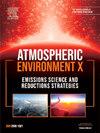沙特阿拉伯王国的污染物变化
IF 3.4
Q2 ENVIRONMENTAL SCIENCES
引用次数: 0
摘要
空气污染对生态系统、公共卫生和城市地区构成重大威胁。本研究分析了沙特阿拉伯(KSA)地区O3、CO、NOx和SO2的时空格局,并对东部工业地区Al-Ahsa和西部山区Al-Baha进行了比较。利用CAMS数据(2003-2023),我们研究了15个压力水平的污染物分布和风的关系。由于高温和下沉空气,O3在夏季达到峰值(110 DU),冬季最低(70 DU)。夏季O3也受垂直运动的影响。CO浓度在冬季最高(22 g/m2),与燃料燃烧有关,在夏季最低,因为温度较高和羟基自由基升高。西部地区氮氧化物峰值出现在夏季(0.8 g/m2),冬季/早春下降。SO2在秋季最高(1.4 g/m2),夏季最低。东部氮氧化物和二氧化硫的波动与当地的排放和气象有关,夏季最低。CO变化最小,SO2变化最大,其次是NOx和O3。趋势表现为西南地区O3显著增加,西南和东南地区CO普遍减少但上升,NOx微弱增加(除中部地区减少外),SO2在工业区增加但普遍下降。这些不同的趋势突出了排放和人类活动对整个沙特阿拉伯地区污染物行为的强烈区域影响。本文章由计算机程序翻译,如有差异,请以英文原文为准。
Pollutants variability over the Kingdom of Saudi Arabia
Air pollution poses significant threats to ecosystems, public health, and urban areas. This study analyzed the spatiotemporal patterns of O3, CO, NOx, and SO2 across Saudi Arabia (KSA), comparing industrial Al-Ahsa (east) with mountainous Al-Baha (west). Using CAMS data (2003–2023), we examined pollutant distributions and wind relationships across 15 pressure levels. O3 peaks in summer (110 DU) due to high temperatures and subsiding air, with winter lows (70 DU). Summer O3 is also influenced by vertical motion. CO concentrations are highest in winter (22 g/m2), linked to fuel combustion, and lowest in summer due to higher temperatures and elevated hydroxyl radicals. In the western region, NOx peaks in summer (0.8 g/m2) and dips in winter/early spring. SO2 is highest in autumn (1.4 g/m2) and lowest in summer. Eastern NOx and SO2 fluctuations are tied to local emissions and meteorology, with summer minima. CO shows the least variability, while SO2 has the most, followed by NOx and O3. Trends reveal O3 significantly increasing in southwestern KSA, CO generally decreasing but rising in the southwest and southeast, NOx showing weak increases (except central decreases), and SO2 increasing in industrial areas but declining broadly. These diverse trends highlight the strong regional impact of emissions and human activities on pollutant behavior across KSA.
求助全文
通过发布文献求助,成功后即可免费获取论文全文。
去求助
来源期刊

Atmospheric Environment: X
Environmental Science-Environmental Science (all)
CiteScore
8.00
自引率
0.00%
发文量
47
审稿时长
12 weeks
 求助内容:
求助内容: 应助结果提醒方式:
应助结果提醒方式:


